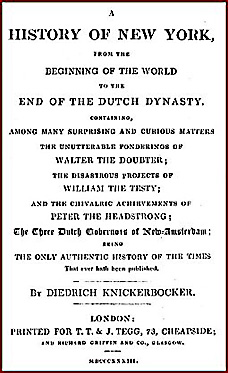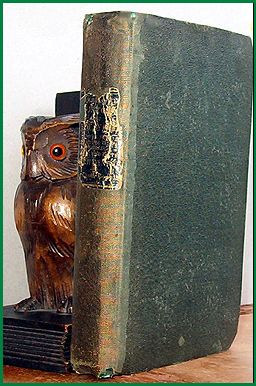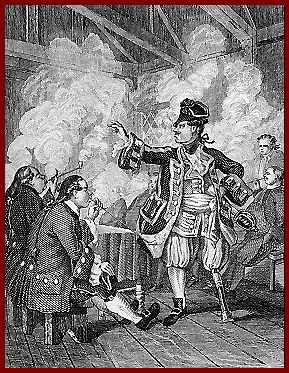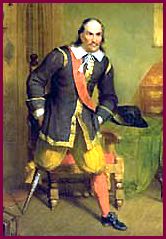New Amsterdam
|
|||||||||||||||||
|
Lead pencil notes inside the cover-page say: Sotheby London. Probably helpful for tracing is the last line on the black title-label: „Cloth Boards". Could it mean a product line of books in linen bookbinding? This one has linen-cloth binding. Measures 155 x 100 mm or 6" x 4", 312 pages.
| |||||||||||||||||
 |
 |
||||||||||||||||
 |
Opposite is a striking illustration of Peter Stuyvesant floating in clouds of tobacco smoke. (Del.t HEATH, sc. SHARPE). I like this rare engraving very much. It reflects perfectly the gentle satire of these humorous pages. No other illustrations.
I was looking many years for this book. Long time ago I followed Washington Irving's footsteps to his romantic living place inside the ancient palace of the Alhambra in Grenada and liked his book (1832) about his stay in Spain. The second time I crossed his way on the search for more information about Peter Stuyvesant. A friend told me, I should look for Knickerbockers book called: A History of New York. Very difficult before the Internet era and if you live on a small tropical island. I didn't miss much. There is little factual information about Stuyvesant in this book. | ||||||||||||||||
|
Why my curiosity? Living on the Dutsch island of Sint Maarten for many years, every child knew the story of the director of the Dutch West India Company and how he lost his leg. Peter Stuyvesant sailed on his Blauwe Haahn on Palm Sunday 1644 with ten other ships from Curacao to this island intended to take it from the Spaniards because of its richness in salt. Salt was very important for the Dutch fishing industry. The Spaniards themselves had plenty of salt in Spain and Portugal and dictated the price, because they needed the money to finance their Eighty Years War against Holland. The Dutch undercut the Spanish monopolization, where they could. Thus, the battle went on. When hoisting his flag on Belair Hill, a Spanish bullet hit Stuyvesants right leg. It had to be amputated aboard ship. Sint Maarten remained Spanish for four more years and the surviving Stuyvesant sailed on to New Amsterdam, where the booty, plundering the continent, was much more promising. I instead told tourist people not so familiar with Sint Maarten's island history a different story. The amputation was for an other reason. On duty-free Sint Maarten tons of cigarettes of all famous brands including certainly Stuyvesant changed hands every day. Stuyvesants leg had to be taken off because of circulatory disorders, smoking much too much. What a smoker he and his Dutch fellows really were shows the print I now own, Stuyvesant surrounded by five men puffing clouds of pipe smoke like volcanoes. As it mostly happens, as soon as you approach a subject, you detect new territories. Behind Irvins work appear new aspects reflecting actual problems. They are in straight connection with his theme, that is the building of New York and consequently the annexation by brute force of the whole continent. Wise and British as he was, he shifted the dirty job of the first fifty years of conquest to the Dutch, but was still too shy to publish his work under his real name. He used the family name of an early Dutch colonist, a brand name since then for early settlers. You will encounter analytical essays of his text, concerning the right of discovery, of cultivation foreign countries, of civilization foreign people, of exterminate them by gunpowder and so on. History is always as the winner sees it. If Irving says, the right to possess America was just the final result of struggle for power, than he hurts the self-reliance of many Americans to feel good to be an American. Irving is skeptical about the quality of that kind of civilization, that the Old World had brought to the New. His Knickerbocker believes already 200 years back from now, these 50 years of Dutch occupation were kind of a garden of Eden destroyed by so-called democracy and materialism. Maybe it was for these poor men a paradise at the beginning. No apples raining down, but buffaloes for food and open traps Hudson River upwards to catch the most precious fur to become rich.
Not just as comic he presents the gigantic question about the ownership of America at the end of Book I. Here he overturns the evolution of history and lets the moon population take possession of the earth. They have plenty of good reasons to do so - missionary reasons. Their man on the moon illuminates generously since eternity the howling wilderness, where those two legged animals would live night by night in the dark without the Lunatics help. They speak a different language and are of a horrible whiteness instead of moon-green. This goes on and on and ends for us earthy people as it ended for the American Indians. By the way: Irving was born as the eleventh child to a Scottish father from the Orkney Islands and an English mother at the end of the War of Independence, therefore his first name was Washington. He died at the outbreak of the Civil War 76 years later. Understandably he spent much of his life in Europe. He was the first American writer who tried to make a profession and a living out of it. It is well worth to look into some internet addresses, especially "lehigh.edu", hudsonvalley.org and others. Klick „Kontakte! There is even an E-text-version of the entire book (150 pages Din A4) from Arthurs Classic Novels. But remember, the author modified his text from edition to edition. To find out, why he did this, is a study by itself. Nowadays it might have undergone many more text modifications for different reasons. |
|||||||||||||||||
|
Just to put things straight: Stuyvesant had lost his right leg and not his left one. It was amputated under the knee. Careless engravers use a given pattern of a drawing as it is and not as a reflected image. The plunder could have also originated from a misinformed artist painting the wood leg on the left side. Peg Leg Pete, as he was nicknamed in NY, decorated his wooden leg with silver nails. The famous man was born A.D. 1610 in nice little Weststellingwerf in Friesland, Holland. |
 |
||||||||||||||||
